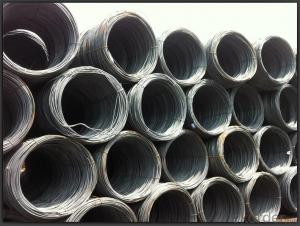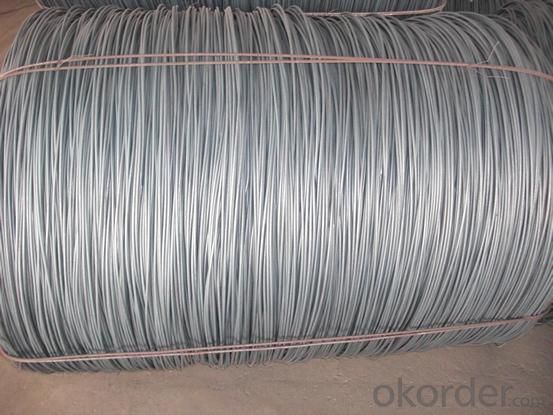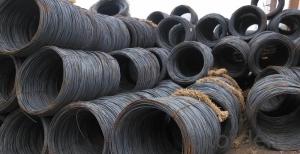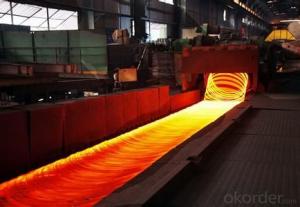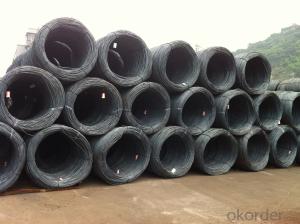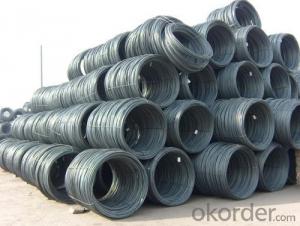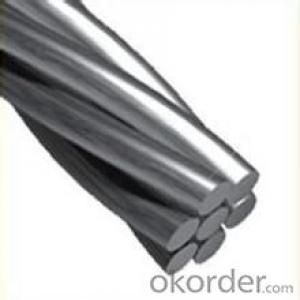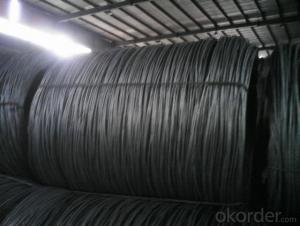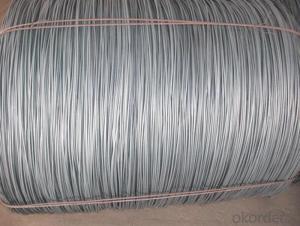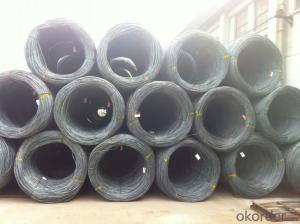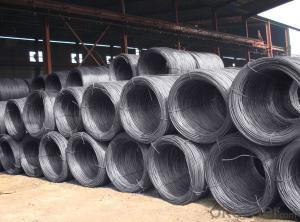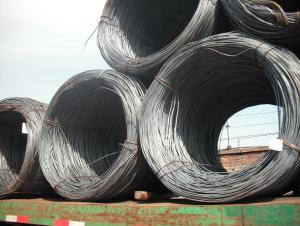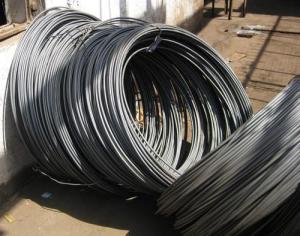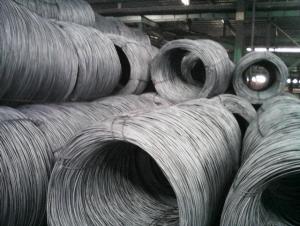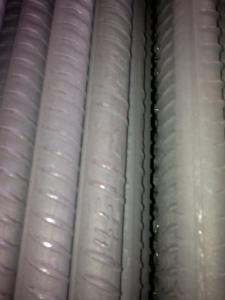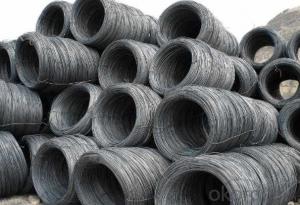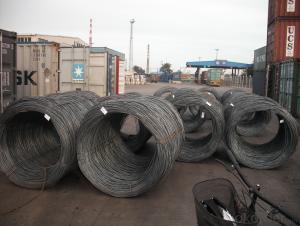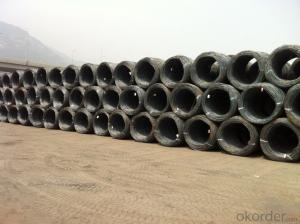Wire Rod Hot Rolled High Quality SAE1008B
- Loading Port:
- Tianjin
- Payment Terms:
- TT OR LC
- Min Order Qty:
- 25 m.t.
- Supply Capability:
- 2000000 m.t./month
OKorder Service Pledge
OKorder Financial Service
You Might Also Like
Specification
Product Description:
OKorder is offering Wire Rod Hot Rolled High Quality SAE1008B at great prices with worldwide shipping. Our supplier is a world-class manufacturer of steel, with our products utilized the world over. OKorder annually supplies products to European, North American and Asian markets. We provide quotations within 24 hours of receiving an inquiry and guarantee competitive prices.
Product Applications:
After Wire Rod Hot Rolled High Quality SAE1008B shaped into coil and delivery as finished product, including round, square, rectangular, hexagonal and so on. Since most of the products are round, it is generally called wire rod. Carbon steel wire rod is widely used in construction and manufacturing. Carbon steel wire rod is mainly used for reinforcement of reinforced concrete and welded structure or reprocessed (roberts , nail, etc.) materials, especially used to produce wire drawing, welding electrode, nails, spring, electronic, precise machinery parts and so on.
Product Advantages:
OKorder's Wire Rod Hot Rolled High Quality SAE1008B are durable, strong, and resist corrosion.
Main Product Features:
· Premium quality
· Prompt delivery & seaworthy packing (30 days after receiving deposit)
· Corrosion resistance
· Can be recycled and reused
· Mill test certification
· Professional Service
· Competitive pricing
Product Specifications:
Manufacture: Hot rolled
Grade: SAE1008 SAE 1006
Certificates: ISO, SGS, BV, CIQ
Diameter: 5.5mm, 6.5mm, 7mm,8mm,9mm,10mm,12mm,14mm, as per customer request
Packaging: Export packing, nude packing, bundled
Grade | Chemical Composition (%) | |||||
C | Mn | S | P | Si | B | |
SAE1008B | 0.10max | 0.32max | 0.045max | 0.040max | 0.30max | 0.0008min |
Mechanical properties | ||||||
Yield strength(N/mm2) | Tensile strength(N/mm2) | Elongation (%) | ||||
≥195 | 350-380 | ≥32 | ||||
FAQ:
Q1: Why buy Materials & Equipment from OKorder.com?
A1: All products offered byOKorder.com are carefully selected from China's most reliable manufacturing enterprises. Through its ISO certifications, OKorder.com adheres to the highest standards and a commitment to supply chain safety and customer satisfaction.
Q2: How soon can we receive the product after purchase?
A2: Within three days of placing an order, we will begin production. The specific shipping date is dependent upon international and government factors, but is typically 7 to 10 workdays.
Q3: Can stainless steel rust?
A3: Stainless does not "rust" as you think of regular steel rusting with a red oxide on the surface that flakes off. If you see red rust it is probably due to some iron particles that have contaminated the surface of the stainless steel and it is these iron particles that are rusting. Look at the source of the rusting and see if you can remove it from the surface.
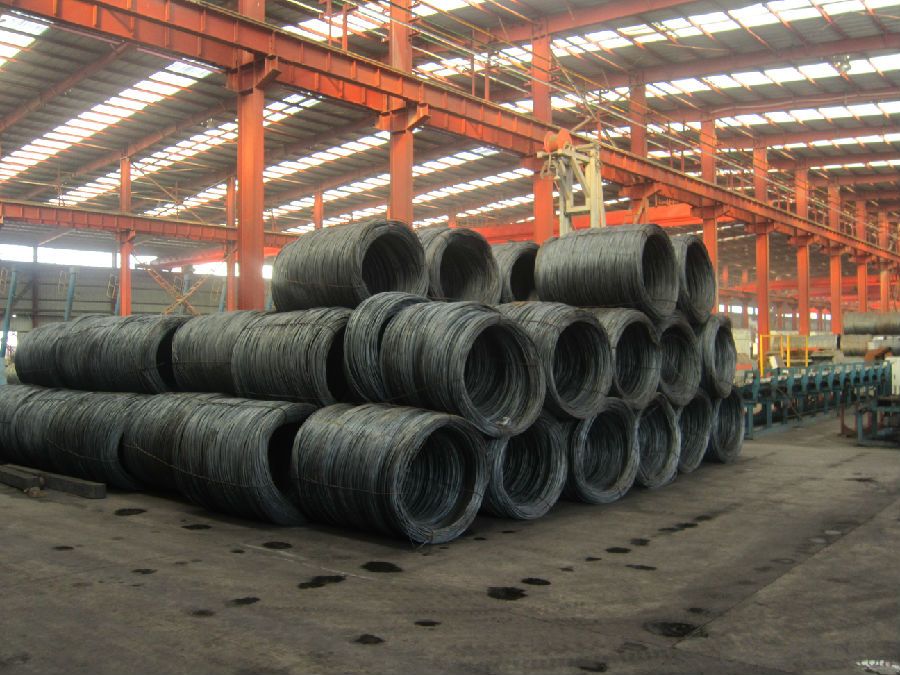
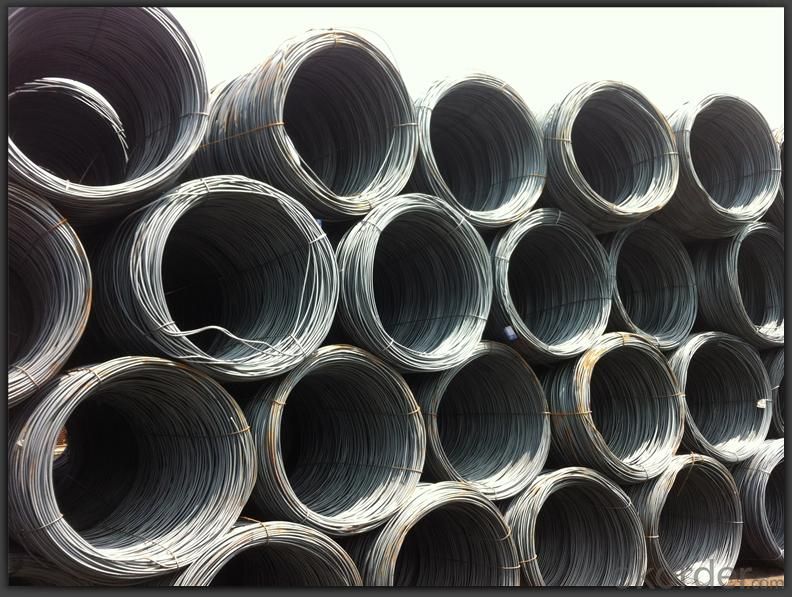
- Q:What are the factors that influence the mechanical properties of steel wire rod?
- The factors that influence the mechanical properties of steel wire rod include the composition of the steel, the heat treatment processes it undergoes, the manufacturing techniques used, and any additional treatments or coatings applied to the rod. Additionally, factors such as the diameter and surface finish of the wire rod can also impact its mechanical properties.
- Q:What are the different mechanical tests conducted on steel wire rod?
- There are several mechanical tests conducted on steel wire rod, including tensile strength test, hardness test, impact test, and fatigue test. These tests help determine the strength, hardness, toughness, and durability of the steel wire rod, ensuring its suitability for various applications.
- Q:What are the different types of steel wire rod coating materials?
- Steel wire rods can be coated with various materials, each with its own purpose and advantages. Different types of coatings include: 1. Galvanizing: Zinc coating is widely used for steel wire rods and offers excellent corrosion resistance. It protects against rust and environmental factors and can be applied through hot-dipping or electroplating methods. 2. Pretreatment: Phosphate coating is often used before applying other coatings or paints. It enhances adhesion, improves corrosion resistance, and finds application in industries like automotive, construction, and agriculture. 3. Additional Protection: Polymer coatings, made of materials like epoxy, nylon, or polyethylene, provide extra protection against corrosion, abrasion, and mechanical stresses. They are highly durable, resistant to chemicals and extreme temperatures. 4. Enhanced Conductivity: Copper coating improves the electrical conductivity of steel wire rods. It is commonly used in the production of electrical wires and cables that require high conductivity. 5. High Resistance: Chrome coating has excellent resistance to corrosion and wear. It is applied to steel wire rods used in harsh environments or exposed to high temperatures. 6. Lightweight and Corrosion-Resistant: Aluminum coating provides a corrosion-resistant layer to steel wire rods while keeping them lightweight. It is often used in aerospace and automotive industries for weight reduction and durability. 7. Aesthetic Appeal: Organic coatings, like polyurethane or acrylic paints, offer both aesthetic appeal and protection against corrosion and UV rays. They are suitable for applications where wire rods will be visible or exposed to outdoor conditions. Choosing the right coating material for steel wire rods depends on specific requirements and intended use. Factors such as corrosion resistance, electrical conductivity, durability, and environmental conditions should be considered to ensure optimal performance.
- Q:What are the different formability testing methods for steel wire rod?
- There are several different formability testing methods that can be used to evaluate the behavior of steel wire rod. These methods are designed to assess the ability of the wire rod to deform and bend without cracking or breaking. Some of the common formability testing methods for steel wire rod include: 1. Cupping test: This test involves placing a blank of the steel wire rod into a shallow die and applying a controlled force to deform the material. The depth of the cup formed before cracking or fracturing occurs is measured to evaluate the formability of the wire rod. 2. Erichsen test: In this test, a hemispherical punch is used to deform the steel wire rod until a crack or fracture occurs. The maximum punch depth before failure is measured and used as an indicator of the wire rod's formability. 3. Tensile test: This is a widely used test to evaluate the mechanical properties of materials, including the formability of steel wire rod. The wire rod is pulled in tension until it fractures, and various parameters such as elongation, reduction in area, and ultimate tensile strength are measured and analyzed. 4. Bend test: This test involves bending the wire rod to a specified angle and examining the surface for cracks or fractures. The angle at which the wire rod fails to maintain its original shape indicates its formability. 5. Flattening test: In this test, the wire rod is flattened between two parallel plates until it fractures. The maximum load or pressure required to cause failure is measured and used as an indicator of formability. 6. Hole expansion test: This test evaluates the ability of the wire rod to deform and expand without cracking when subjected to a punching force. The maximum hole diameter that can be obtained without failure is measured, indicating the formability of the wire rod. These formability testing methods help manufacturers and researchers assess the suitability of steel wire rod for various applications, such as automotive components, construction materials, and manufacturing processes. By understanding the formability characteristics of the wire rod, engineers can make informed decisions regarding material selection and process optimization.
- Q:How is steel wire rod used in the manufacturing of wire forms for solar panels?
- Steel wire rod is used in the manufacturing of wire forms for solar panels as it serves as the base material for creating the intricate shapes and structures required. Using steel wire rod, manufacturers can bend, shape, and weld the wire to create the framework and support structures for the solar panels. This ensures durability and strength, allowing the panels to withstand various environmental conditions and securely hold the photovoltaic cells in place.
- Q:What are the different types of steel wire rod coatings for corrosion resistance?
- There are several types of steel wire rod coatings available for corrosion resistance, including galvanized coatings, zinc-aluminum coatings, and epoxy coatings. These coatings provide a protective barrier against environmental elements and prevent the steel wire rod from rusting or corroding over time.
- Q:What are the standard straightness requirements for steel wire rod?
- The standard straightness requirements for steel wire rod are typically specified by industry standards or customer specifications. These requirements ensure that the wire rod has a straight and uniform shape, which is crucial for its intended applications. One common straightness requirement for steel wire rod is the maximum allowable deviation from a straight line. This is usually specified as a maximum bow or camber, which refers to the amount of deviation from a straight line when the wire rod is laid flat on a surface. This requirement ensures that the wire rod can be easily processed and used in various manufacturing processes, such as drawing, cold heading, or welding. Another straightness requirement for steel wire rod is the maximum permissible twist or helix. This refers to the amount of rotation or spiral distortion along the length of the wire rod. Excessive twist can affect the wire rod's performance, especially in applications where it needs to be threaded through tight spaces or used in precision machinery. In addition to these primary straightness requirements, there may be specific tolerances for straightness at different sections or lengths of the wire rod. For example, the straightness requirement may be more stringent at the ends or along specific portions of the wire rod. These variations in straightness requirements are often determined based on the wire rod's intended application or the customer's specific needs. Overall, the standard straightness requirements for steel wire rod aim to ensure that the product meets the necessary quality standards and can be effectively used in various manufacturing processes. Compliance with these requirements helps to guarantee that the wire rod performs reliably and consistently in its intended applications.
- Q:How is the steel wire rod market segmented by application?
- Steel wire rods are utilized in a wide range of industries, with each sector having specific applications for these rods. The construction industry, for example, commonly incorporates steel wire rods into concrete structures such as buildings, bridges, and highways to enhance their strength and durability. By reinforcing these structures, the rods ensure that they can withstand various forces and maintain stability. Similarly, the automotive industry relies heavily on steel wire rods for manufacturing different components like springs, suspension systems, and wire harnesses. The high tensile strength of these rods makes them suitable for use in automotive systems that face demanding conditions. In the energy sector, steel wire rods play a significant role in the production of power transmission cables and electrical wiring. The conductors manufactured from these rods efficiently transport electricity over long distances while minimizing energy loss. The industrial sector also benefits from the use of steel wire rods, which find applications in machinery, appliances, and manufacturing. These rods are utilized for producing mechanical components like fasteners, bolts, and nuts that require strength and reliability. In addition to these major segments, steel wire rods have diverse applications in sectors such as agriculture, aerospace, and consumer goods. For instance, in agriculture, these rods are used for fencing, trellising, and supporting structures. In aerospace, they contribute to the manufacturing of aircraft cables, suspension systems, and other critical components. Overall, the varied applications of steel wire rods in different industries have led to the segmentation of the steel wire rod market by application. The versatility and strength of these rods make them indispensable in various sectors, enabling the production of robust and reliable products.
- Q:What are the different types of steel wire rod surface cleaning methods after wire drawing?
- After wire drawing, there are various methods available for cleaning the surface of steel wire rod to eliminate any impurities or contaminants. 1. Mechanical Cleaning: This method involves physically eliminating dirt, dust, or other particles from the wire surface using brushes, air blasts, or abrasive materials. It effectively removes larger debris. 2. Chemical Cleaning: Different cleaning agents or solvents are used in this method to dissolve or remove oils, grease, or other contaminants from the wire surface. These agents can be applied through spraying, immersion, or brushing, and rinsing is often necessary to ensure complete removal of residues. 3. Electrolytic Cleaning: By submerging the wire in an electrolyte solution and applying an electric current, this method dissolves and separates surface contaminants. It effectively removes very thin layers of impurities. 4. Pickling: Pickling is a specific type of chemical cleaning that involves immersing the wire in an acid solution to eliminate any oxide layers or scales formed during wire drawing. The acid reacts with the oxides, dissolving them and leaving the wire surface clean for further processing. 5. Ultrasonic Cleaning: High-frequency sound waves create tiny bubbles in a cleaning solution in this method. These bubbles implode near the wire surface, creating a scrubbing action that dislodges and removes contaminants. It is particularly useful for cleaning wire surfaces with complex geometries or hard-to-reach areas. It is crucial to consider the specific requirements of the wire application and the nature of the contaminants when choosing a cleaning method. Each method has its own advantages and limitations, and selecting the most appropriate method is essential to ensure the wire meets the desired cleanliness standards.
- Q:What are the different types of wire mesh for filtration made from steel wire rod?
- Wire mesh for filtration, which is made from steel wire rod, comes in various types. These include: 1. The most common and basic type is plain weave mesh. It is created by weaving the steel wire rod in a simple over-and-under pattern, resulting in a robust and sturdy mesh. Plain weave mesh is suitable for general filtration purposes. 2. Twilled weave mesh is characterized by a diagonal pattern formed by the weave. It has a higher mesh count compared to plain weave, enabling finer filtration. Twilled weave mesh is often employed in applications that require a higher level of filtration. 3. Dutch weave mesh is made by using two different wire diameters for the warp and weft wires. The warp wires are thicker, while the weft wires are thinner. This produces a tightly woven mesh with smaller openings in the weft direction, making it ideal for fine filtration applications. 4. Welded mesh is created by welding the intersecting points of the steel wire rod, resulting in a strong and durable mesh structure. It is commonly used in industrial filtration applications that require high strength and rigidity. 5. Expanded metal mesh is produced by stretching and expanding a sheet of steel wire rod, creating diamond-shaped openings. This type of mesh offers excellent strength and rigidity, making it suitable for heavy-duty filtration applications. Each type of wire mesh has unique filtration capabilities and is suitable for specific applications. The choice of wire mesh for filtration made from steel wire rod depends on factors such as the desired filtration level, strength requirements, and the specific environment in which it will be utilized.
1. Manufacturer Overview |
|
|---|---|
| Location | |
| Year Established | |
| Annual Output Value | |
| Main Markets | |
| Company Certifications | |
2. Manufacturer Certificates |
|
|---|---|
| a) Certification Name | |
| Range | |
| Reference | |
| Validity Period | |
3. Manufacturer Capability |
|
|---|---|
| a)Trade Capacity | |
| Nearest Port | |
| Export Percentage | |
| No.of Employees in Trade Department | |
| Language Spoken: | |
| b)Factory Information | |
| Factory Size: | |
| No. of Production Lines | |
| Contract Manufacturing | |
| Product Price Range | |
Send your message to us
Wire Rod Hot Rolled High Quality SAE1008B
- Loading Port:
- Tianjin
- Payment Terms:
- TT OR LC
- Min Order Qty:
- 25 m.t.
- Supply Capability:
- 2000000 m.t./month
OKorder Service Pledge
OKorder Financial Service
Similar products
Hot products
Hot Searches
Related keywords
